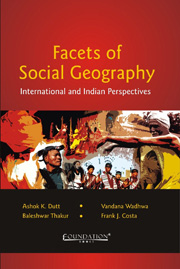Book contents
- Frontmatter
- Contents
- Foreword
- Preface
- Acknowledgements
- List of Contributors
- I Introductory Framework: Allen G. Noble's Contribution to Social Geography
- II Conceptual and Theoretical Basis of Social Geography
- III Social Geography from a Global Perspective
- IV Social Geography in the Indian Context
- V Indian Social Geography: City and State Context
- 24 Health Infrastructure and Healthcare Services in Uttar Pradesh
- 25 Status of Women in Aligarh Muslim University, India
- 26 Social Geographies of Collective Action: A Case Study of India's Chipko Movement
- 27 Sacredscape and Manescape: The Sacred Geography of Gaya, India
- 28 Madurai: A Holy City of Pilgrimage
- 29 Assessment and Dynamics of Urban Growth in the City of Kolkata
- 30 Socioeconomic and Demographic Conditions of the Slums of Hyderabad
- 31 Writings of Mirza Ghalib: A Study in Literary Geography
- 32 Geographic Images of Old Delhi through Literature
- 33 Spatial and Temporal Characteristics of Elite Residential Colonies in Delhi, 1982–2004
- Index
32 - Geographic Images of Old Delhi through Literature
from V - Indian Social Geography: City and State Context
Published online by Cambridge University Press: 05 June 2012
- Frontmatter
- Contents
- Foreword
- Preface
- Acknowledgements
- List of Contributors
- I Introductory Framework: Allen G. Noble's Contribution to Social Geography
- II Conceptual and Theoretical Basis of Social Geography
- III Social Geography from a Global Perspective
- IV Social Geography in the Indian Context
- V Indian Social Geography: City and State Context
- 24 Health Infrastructure and Healthcare Services in Uttar Pradesh
- 25 Status of Women in Aligarh Muslim University, India
- 26 Social Geographies of Collective Action: A Case Study of India's Chipko Movement
- 27 Sacredscape and Manescape: The Sacred Geography of Gaya, India
- 28 Madurai: A Holy City of Pilgrimage
- 29 Assessment and Dynamics of Urban Growth in the City of Kolkata
- 30 Socioeconomic and Demographic Conditions of the Slums of Hyderabad
- 31 Writings of Mirza Ghalib: A Study in Literary Geography
- 32 Geographic Images of Old Delhi through Literature
- 33 Spatial and Temporal Characteristics of Elite Residential Colonies in Delhi, 1982–2004
- Index
Summary
‘Literature represents a source of geographical data and perceptions that are mostly untapped by geographers. Among Indian writers of fiction in both English and Hindi, the city of Delhi, the capital of India, is ‘an idea with physical boundaries.’ Both Hindu and Muslim authors regard the capital city with mixed emotions of reverence and resentment. The urban environment of Delhi presents sharply contrasting images of security, retreat, familiarity, noise, crowds and filth. Authors carefully describe both the city's physical frame and the quality of its communal life. This essay is intended to examine the ‘idea’ of Old Delhi (Shahjahanabad, the walled city) in its contrasting facets across the writings of representative Indian authors. Old Delhi has been a living city since the seventeenth century and forms a part of the much larger Delhi Metropolitan Area.
Old Delhi: The Traditional City
The crowded world of Old Delhi is vividly portrayed in numerous novels and short stories including Jhabvala's The Householder (1960), Yadav's Andekhe Anjan Pul (‘Unseen, Unknown Bridges’) (1963), Ali's Twilight in Delhi (1966), Rakesh's Lingering Shadows (1970), Chopra's Jaren (‘The Roots’) (1972), Vaid's A Blind Alley (1972), Bista's Beete Din (‘Bygone Days’) (1974), Nahal's My True Faces (1978), and many others.
The city of Old Delhi, which now spreads even beyond the old walls of Shahjahanabad, mainly towards its west and northwest with the traditional settlement pattern, was developed largely after the Revolt of 1857.
- Type
- Chapter
- Information
- Facets of Social GeographyInternational and Indian Perspectives, pp. 588 - 601Publisher: Foundation BooksPrint publication year: 2012



